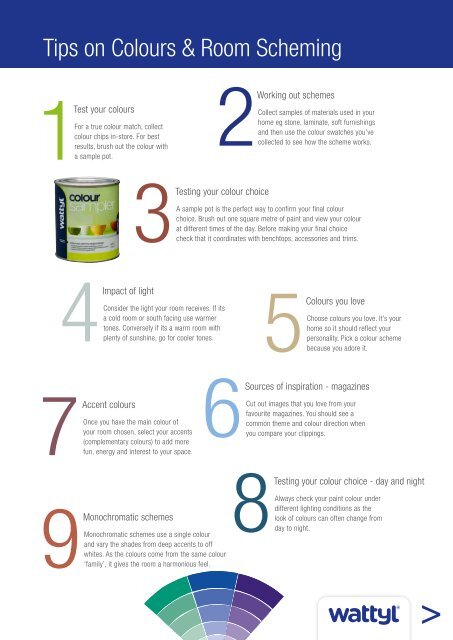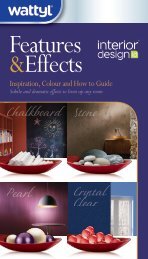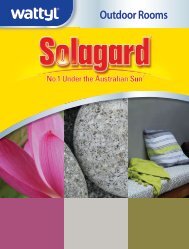Tips on Colours & Room Scheming - Wattyl
Tips on Colours & Room Scheming - Wattyl
Tips on Colours & Room Scheming - Wattyl
Create successful ePaper yourself
Turn your PDF publications into a flip-book with our unique Google optimized e-Paper software.
<str<strong>on</strong>g>Tips</str<strong>on</strong>g> <strong>on</strong> <strong>Colours</strong> & <strong>Room</strong> <strong>Scheming</strong><br />
1Test your colours<br />
For a true colour match, collect<br />
colour chips in-store. For best<br />
results, brush out the colour with<br />
a sample pot.<br />
3<br />
2Working out schemes<br />
Collect samples of materials used in your<br />
home eg st<strong>on</strong>e, laminate, soft furnishings<br />
and then use the colour swatches you’ve<br />
collected to see how the scheme works.<br />
Testing your colour choice<br />
A sample pot is the perfect way to c<strong>on</strong>firm your final colour<br />
choice. Brush out <strong>on</strong>e square metre of paint and view your colour<br />
at different times of the day. Before making your final choice<br />
check that it coordinates with benchtops, accessories and trims.<br />
4 5<br />
Impact of light<br />
C<strong>on</strong>sider the light your room receives. If its<br />
a cold room or south facing use warmer<br />
t<strong>on</strong>es. C<strong>on</strong>versely if its a warm room with<br />
plenty of sunshine, go for cooler t<strong>on</strong>es.<br />
<strong>Colours</strong> you love<br />
Choose colours you love. It’s your<br />
home so it should reflect your<br />
pers<strong>on</strong>ality. Pick a colour scheme<br />
because you adore it.<br />
7Accent colours<br />
Once you have the main colour of<br />
your room chosen, select your accents<br />
(complementary colours) to add more<br />
fun, energy and interest to your space.<br />
6Sources of inspirati<strong>on</strong> - magazines<br />
Cut out images that you love from your<br />
favourite magazines. You should see a<br />
comm<strong>on</strong> theme and colour directi<strong>on</strong> when<br />
you compare your clippings.<br />
9M<strong>on</strong>ochromatic schemes<br />
M<strong>on</strong>ochromatic schemes use a single colour<br />
and vary the shades from deep accents to off<br />
whites. As the colours come from the same colour<br />
‘family’, it gives the room a harm<strong>on</strong>ious feel.<br />
8Testing your colour choice - day and night<br />
Always check your paint colour under<br />
different lighting c<strong>on</strong>diti<strong>on</strong>s as the<br />
look of colours can often change from<br />
day to night.<br />
>
<str<strong>on</strong>g>Tips</str<strong>on</strong>g> <strong>on</strong> <strong>Colours</strong> & <strong>Room</strong> <strong>Scheming</strong><br />
10<br />
Painting with bright colours<br />
When painting deep or bright colours, it is recommended to use a grey undercoat to ensure you<br />
achieve the final colour you desire. Using a grey undercoat evens out the appearance of the<br />
paint and reduces the number of coats required. Gives your topcoat maximum hiding power and<br />
richer colour as a result. Ask your in -store paint expert for the recommended undercoat colour.<br />
11<br />
Feature wall<br />
Feature walls are an excellent way to introduce a c<strong>on</strong>trasting colour or<br />
effect into your room. Choose either the wall that faces you as you enter<br />
the room or a wall with an interesting angle. Try to avoid walls that have<br />
windows and doors as this will lessen the impact of the feature.<br />
12<br />
Creating a designer look<br />
Deep and bold colours are a great way of creating interest and vitality<br />
in your living spaces. To establish which colours to use, create a mood<br />
board or scrap book with your collecti<strong>on</strong> of colour chips , and use fabric<br />
from your cushi<strong>on</strong>s, carpet swatches or photographs of your furniture.<br />
13<br />
Be patient<br />
It’s great to collect paint chips when planning a room, but hold<br />
off making final choices until you’ve developed an overall room<br />
scheme. Paint is available in literally an infinite array of colors<br />
and is the most versatile element of your room decor, the easiest<br />
to change, and the least expensive. Get ideas but make the final<br />
decisi<strong>on</strong> after rugs, wallpaper, and fabrics are finalised.<br />
14<br />
Know the lingo<br />
Primary colour: Red, yellows and blues are<br />
primary while sec<strong>on</strong>dary colours are those<br />
mixed with primaries (for example,mixing<br />
primary colours blue and yellow makes the<br />
sec<strong>on</strong>dary colour of green).<br />
Complementary colours: <strong>Colours</strong> directly<br />
opposite each other <strong>on</strong> the colour wheel.<br />
Accents: a colour from an opposite end of the<br />
spectrum which highlights the main colour,<br />
usually by c<strong>on</strong>trasting with it.<br />
Tint: A colour made with added white.<br />
Shade: A colour made with black added to it.

















